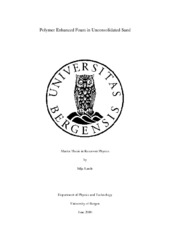| dc.description.abstract | Foam is an EOR technique that significantly can improve the macroscopic sweep efficiency by lowering the gas mobility. Limited stability of conventional surfactants for foam generation is one of the reasons why foam is not being widely used as a common EOR technique. One proposed approach for foam stabilization is the addition of polymers, so called polymer enhanced foam, and is defined here as an integrated EOR (IEOR) technique. The objective of this thesis was to investigate the observed difference in the development of pressure during co-injection of N2 gas and two different foaming solutions, one with and one without polymer for foam stability. Foam generation and flow behavior were studied at core scale to evaluate the potential of polymer enhanced foam for IEOR application. In addition, bulk foam stability with or without the presence of different oils was studied using surfactant as foaming agent. Foam stability was studied during sixteen bulk foam coalescence tests by measuring the half-life of foam with and without the presence of oil. Changes in foam texture and foam height were observed visually, and destruction mechanisms were studied during the foam decay regime. Without oil, foam columns had constant height and a continuous thinning of lamellae by gravity was observed. With oil, the foam columns divided into several parts with a rapid reduction of foam height, depending on amount of oil and oil composition. Foam generation with and without the addition of polymers for added stability was studied during fourteen co-injections in unconsolidated sand packs. The development in absolute pressure in five pressure ports placed along the sand pack and the pressure gradient across four sections was analyzed to establish if stable pressures were achieved. Stable pressures were achieved using regular surfactants during co-injection with N2 gas, whereas the pressure did not stabilize with the addition of polymer solution. The pressure drop across the four sections of the sand pack was used to calculate the apparent viscosity of the generated foam to compare flow and foam ability. A variation in apparent foam viscosity was observed along the core length, and in general the apparent foam viscosity increased with higher permeability. One co-injection of N2 gas and surfactant+polymer solution was conducted in PET-CT scanner to investigate the local development of the foaming solution. The results showed that saturation development of the foaming solution was not uniform across the scanned section of the sand pack and within t=7 PV the saturation had not reached stable state. | en_US |
